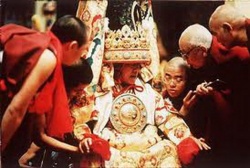Nechung Dorje Drayang Ling Monastery
Nechung Dorje Drayang Ling Monastery has an important place in Tibetan history as the seat of Nechung, the State Oracle of Tibet.
The original Nechung Monastery lies just below Drepung, four miles west of Lhasa, the nation’s capital.
The reestablished monastery in exile is in Dharamsala, Himachal Pradesh, India.
There are three Nechung centers in the United States — New York, San Francisco, and Hawaii.
Nechung’s roots must be traced back to the 8th century AD, during the reign of King Trisong Deutsan, to understand its significance in Buddhist culture and Tibetan history.
At the time, the Indian Buddhist master Guru Padmasambhava appointed Pehar to be Protector of Tibet and Buddhism at the temple of Samye.
A small temple was built by Trisong Deutsan’s son, Mune Tsanpo, at the present site of Nechung Monastery in Lhasa site.
Ba Pelyang became its first abbot and an image of the goddess Tara was brought from Samye to this monastery, aptly named at the time to be “Nechung Yulo Ko” (the small pureland of Tara).
At that time, Samye, Tibet's first monastic institute, was known as Nechen (the Larger place), and at Nechung (the Smaller place) was a shrine dedicated to Pehar.
In the 16th century, the 2nd Dalai Lama (1476-1542) established initial contact and developed a close relationship with Nechung as His personal protector.
The lineage of the Mediums was officially established at that time.
The monastery was rebuilt during the reign of the Great 5th Dalai Lama, Ngawang Lobsang Gyatso (1617-1682), who was also the principal architect of Nechung Monastery, and renamed it Nechung Dorje Drayang Ling (Immutable Place of Melodious Sound).
It was under His advice and guidance that Nechung was expanded in 1681 and completed in 1683 during the regency of Desi Sangye Gyatso.
The Great 5th designated the Nechung Oracle to be the chief protector of Tibet, its’ government and people; and responsible for peace and Harmony on earth. Since then, the monastery has remained the official abode of the State Oracle of Tibet.
The 5th Dalai Lama also composed Drayang-Ma (Melodic Chant), a text of self-generation practice and an invocation of the protector, which was incorporated into the monastic rites.
Other specialized prayers, rituals and training of many lineages were initiated into the monastery's practices and have been preserved until the present time.
The monastery shared a particularly special relationship with the Great 13th Dalai Lama, Thupten Gyatso (1876-1933), who relied on Nechung extensively.
The Nechung Protector therefore has been the main consultant dealing with the various spiritual and temporal matters of the Tibetan government and the succession of Dalai Lamas.
